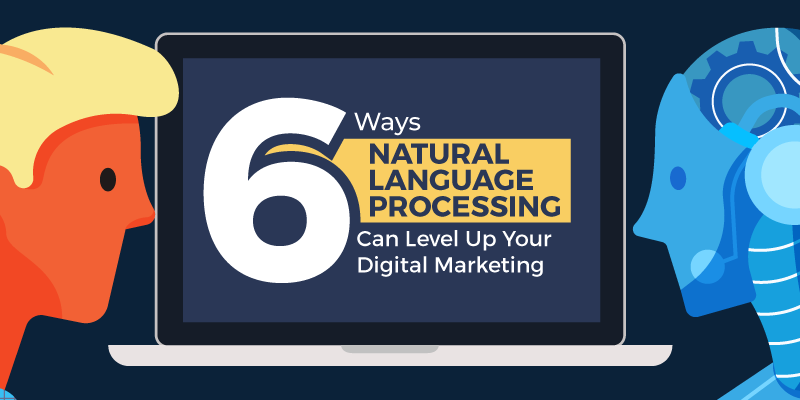If Natural Language Processing (NLP) sounds like some obscure concept to you, it’s because it is. NLP falls under artificial intelligence (AI), which in itself is a very technical subject.
But, contrary to what you might think, NLP is not that difficult to understand.
What Is Natural Language Processing?
Natural Language Processing (NLP) is a field of computer science, specifically artificial intelligence, which focuses on developing in computers the ability to read, translate, or summarize text—whether in visual or audio form—and figure out what they mean, like how humans can.
In addition, NLP is good at dealing with the nuances of human or natural language, such as spelling errors, slang or informal terms, or regional accents, enabling machines to perform tasks as accurately as possible.
Through NLP, a computer can understand human or natural language. NLP uses syntax and semantics to help computers and systems think like humans based on the data they receive, then perform a relevant response. Just think how Google or other sites can give you relevant results even though your search term isn’t spelled or phrased correctly—that’s NLP at work right there!
To serve its users the best browsing experience, Google uses NLP to identify the context or intent of search queries. What this means for your digital marketing team is you can also use NLP in your campaigns to make sure that your message reaches your target audience—people or organizations who can benefit from your content, product, or service.
In this infographic, you’ll see the many ways NLP marketing revolutionizes the digital space, so you can identify the different possibilities to use this technology to your own advantage.
![[Infographic] 6 Ways Natural Language Processing Can Level Up Your Digital Marketing](https://www.spiralytics.com/wp-content/uploads/2020/10/SPIRA_-INFO22_SEPT.png)
How NLP is Used in Digital Marketing
NLP makes it easy for you to process tons of language data collected from Google searches, website visits, or social media pages and then use the information to improve your marketing strategies across these channels.
NLP can help you find the perfect keywords to reach people more effectively. Previously, marketers only needed to create and optimize content mainly for search engines like Google. As long as you included enough target keywords, your content would have a good chance of being indexed.
Over time, Google saw the need to tweak those algorithms with their Panda update to make sure that websites only published useful and relevant content for users.
6 NLP Marketing Techniques That Boost Your Digital Presence
Applying Natural Language Processing in marketing can help you provide better services, understand your leads better, and make your marketing efforts more efficient and targeted. Here are a few ways you can utilize the power of NLP in your marketing efforts.
1. Use chatbots for lead capture and qualification
With NLP, you can utilize bots to handle customer queries almost instantly and collect information about people visiting your site. Chatbots can also help identify if someone is ready to buy and use that insight to pass hot leads over to sales for immediate action.
Countless customers are going online to search for information, content, products, and so on, at any given time each day. Google receives around 5.8 billion searches a day, which translates to lots of opportunities for your business to capture leads. However, customers don’t like the idea of having to wait too long for someone to respond to their queries.
2. Can be used as a social listening tool for sentiment analysis

NLP technologies like social listening tools allow you to find language clues like positive, negative, or neutral terms that people use to describe your business or content. You can use the insights from social listening to conduct sentiment analysis. Knowing how people feel about your brand should help you plan how to maintain good brand perception.
NLP techniques like sentiment analysis allow brands to recalibrate their message and branding to fit their audience. A lot about digital marketing entails measuring how well your campaigns are doing. This task is critical as you want to make sure that you’re using the right strategies or if you could improve those that are not contributing to your efforts.
3. Optimize voice search using speech recognition
Speech recognition, or speech-to-text, is the ability of NLP to convert audio data into text that is easier to analyze and sort. Voice commands and queries can give marketers information about what customers are looking for that might be missing from text-only search results.
In today’s digital world, customer data can be the lifeblood of any business. As it is, the web already stores unimaginable amounts of text and speech data. In fact, in Q3 2018, smart speaker shipments grew nearly 200%, which shows how virtual assistants like Alexa or Siri have grown in popularity over the years.

NLP’s voice search capabilities can help you target specific audiences, such as consumers who use their voice-activated devices to find things on the web. Since NLP can pick up specific keywords from audio conversations, you can better identify which content or ad matches their needs, interests, or stage in the buying cycle.
4. Make search intent clearer with word sense disambiguation
NLP can identify the correct interpretation of words with multiple meanings using context clues and semantics analysis. This process is called word sense disambiguation. It can help marketers process search queries and requests even if the phrasing is confusing or unfamiliar.
People search in different ways depending on how they express themselves. For instance, someone may enter the keywords “Steps in updating LinkedIn profile,” while someone else might ask, “How to update my profile in LinkedIn.” As you can see, these are two different ways of asking the same thing.
Your goal is to use the right combination of keywords, which will help Google understand that your text or content is a good answer to that query and should, therefore, be included in search engine results.
By using NLP technology, you can identify with different variations of related or relevant keywords, learn how to use them in your content, and optimize your marketing assets better than ever before!
5. Create content with natural language generation
Natural language generation is the ability of AI using NLP to create human-sounding responses or narratives using data. Marketers can use this as a tool to help generate and audit content and quickly create easily readable analyses of data to guide content decisions.
One of your goals as a marketer is to create quality content that can drive traffic to your site and engage visitors. However, you know better that things shouldn’t stop at content creation.
You also need to audit your content assets and conduct competitor research as these things can help ensure that you have all the bases covered. This is where NLP comes handy, allowing you to see if there’s any missing or insufficient content in your blog posts.
You can also use NLP to identify the hottest topics in your industry and create your own content, paving the way for timely and meaningful conversations within the community.
6. Process customer feedback forms to improve customer service
At the end of the day, it’s the customer-first mindset that makes businesses successful. Treading this path means you have to know who your customers are and what motivates them, and then create buyer personas to help tailor-fit your content to their needs.
Today, more and more businesses are using NLP techniques to cull customer data from a broad range of sources—emails, chats, feedback forms, help desk tickets, and the like—and improve the overall customer experience on their website.
NLP Matters for Your Content Marketing
Every good marketer knows that words have the power to stir emotions, behavior, ideas, and actions among people. The growing list of NLP marketing techniques and applications allow you to automate and optimize your content marketing efforts with machine-like efficiency, but also with a truly personal and human touch.
Ready to revolutionize your business?







